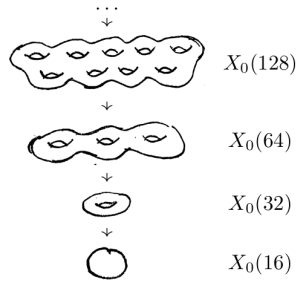Oxford Mathematician Daniel Gulotta talks about his work on $p$-adic geometry and the Langlands program.
"Geometry is one of the more visceral areas of mathematics. Concepts like distance and curvature are things that we can actually see and feel.
Mathematicians like to question things that seem obvious. For example, what if distance did not work the way that we are used to? Normally, we would say that a fraction like $\frac{1}{65536}$ is very close to zero because the denominator is much larger than the numerator, and conversely $65536 = \frac{65536}{1}$ is very far from zero because the numerator is much larger than the denominator. In $p$-adic geometry, we instead choose a prime number $p$, and we say that a fraction $\frac{a}{b}$ is close to zero if $a$ is divisible by a large power of $p$. So for $p=2$, $65536 = \frac{2^{16}}{1}$ is actually $2$-adically very close to zero and $\frac{1}{65536} = \frac{1}{2^{16}}$ is $2$-adically very far from zero. It can be shown that the only 'well-behaved' notions of distance on the rational numbers are the usual one and the $p$-adic ones.
It is difficult to directly relate our intuition about the real world to this $p$-adic notion of distances. One of the challenges of $p$-adic geometry is to find ways of framing familiar concepts so that they still make sense in the $p$-adic world.
A common technique in geometry is to study a complicated space by chopping it into smaller, simpler pieces and studying how those pieces fit together. For example, a complicated surface could be divided into discs.
A surprising fact about $p$-adic geometry is that the $p$-adic disc is still a very complicated space - it loops back on itself in all sorts of ways. It turns out that the simpler spaces are actually these very large objects called perfectoid spaces. Whereas one can specify a point on the $p$-adic disc with a single $p$-adic coordinate (similar to how a point on the usual disc can be specified by a single complex number), a point on a perfectoid space might be specified by an infinite sequence of coordinates $(x_0,x_1,x_2,\dotsc)$ satisfying $x_i = x_{i+1}^p$ for all $i \ge 0$. So to understand $p$-adic spaces, in addition to cutting them into pieces, we also want to cover those pieces by perfectoid spaces.
I am particularly interested in applications of $p$-adic geometry to the Langlands program, which explores connections between number theory, geometry, and representation theory. One way that geometry enters into the Langlands program is through Shimura varieties. These are geometric spaces whose symmetries have a particularly nice arithmetic description. (Modular curves, a particular kind of Shimura variety, play a significant role in Andrew Wiles's famous proof of Fermat's last theorem.)
Along with Ana Caraiani and Christian Johansson, I have been studying the $p$-adic geometry of Shimura varieties. In particular, we have proved vanishing of certain compactly supported cohomology groups. In plain terms, we have shown that these Shimura varieties do not have any loops of high dimensions. This result has allowed us to improve on Scholze's results on the p-adic Langlands correspondence. The proof involves using techniques from geometric representation theory, namely Weyl groups and the Bruhat stratification, to divide the Shimura variety into pieces and then cover those pieces with perfectoid spaces."
For more on Daniel's work:


